Limestone University is an accredited, independent, non-denominational Christian institution with its residential campus located in Gaffney, South Carolina. The county seat of Cherokee County, Gaffney is within an hour’s drive of the Greenville/Spartanburg and Charlotte metropolitan areas.
Founded on liberal arts principles in 1845, Limestone offers associate, undergraduate, and master’s degree programs on-campus and through its innovative Limestone Online program that reaches across the globe.
Limestone University’s foundation in Christian faith and liberal arts empowers students of all abilities and backgrounds who will invest in themselves and aspire to thrive spiritually, personally, and professionally.
In a compassionate and supportive environment based on Christian principles, Limestone nurtures students to become critical thinkers, strong leaders, and effective communicators who are prepared for successful lives, careers, and continued graduate studies.
After preparing for the move for over two years, Limestone College officially changed its name to Limestone University on July 1, 2020.
As part of that name change, the institution unveiled a new Limestone University logo that kept its traditional school colors of blue and gold the same. Signage was updated across the campus to reflect the name change. The name change also created the opportunity to update and improve Limestone’s branding. Paying homage to Limestone's history, the Curtis Building, its cupola, and the “1845” inscription became prominent fixtures in the new Limestone University logo.
Limestone was well positioned to change its status from a college to a university. The Limestone Master of Business Administration program was approved by the Southern Association of Colleges and Schools in 2011, and its first MBA graduates were conferred in 2014. Four years later, Limestone added a Healthcare Administration concentration to its MBA Program for students seeking leadership careers in healthcare-related fields.
The University added a second graduate program in the fall of 2020 with its Master of Social Work degree. Additional specialized graduate degree programs – that will provide for strong careers and support the economic development of South Carolina – have also been added and more are on the horizon at Limestone.
Including its traditional On-Campus Program and its innovative Limestone Online Program that offers undergraduate and graduate degrees, Limestone is one of the largest private universities in South Carolina.
Limestone University is committed to the liberal arts and sciences and to educating students for leadership, service, and professional responsibility in the 21st century. While receiving a strong foundation in the liberal arts, Limestone is well-known for its pre-professional degree programs.
The University is privileged to have a distinguished and dedicated faculty. Nearly 80 percent of the day faculty possess the Ph.D. or other terminal degree in their academic disciplines. A small student-to-faculty ratio allows Limestone’s students to get individualized attention generally not available at larger institutions.
Students at Limestone are active in campus and community life through social, service, and athletic organizations. The Honors Program challenges those with exceptional intellectual ability; the Adamah Christian Leadership Program serves those interested in deepening their religious commitment; and the Learning Enrichment & Achievement Program (LEAP) fosters academic success for students with learning and attention challenges.
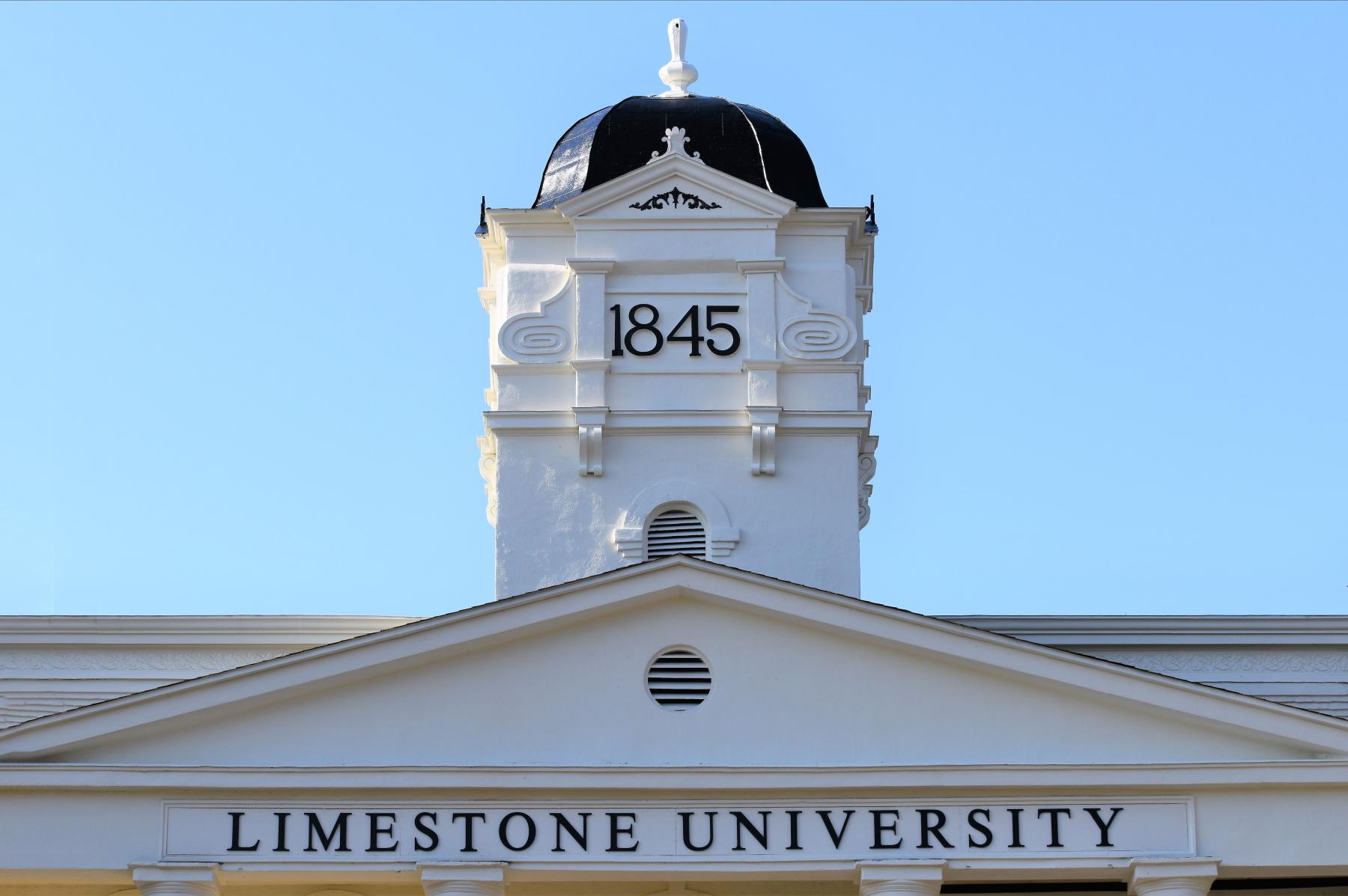
The Drive to University
In April of 2018, unanimous approval was given by the Board of Trustees for Limestone to begin taking steps to move to the status of a university by the 2020 fall semester, which coincides with the liberal arts institution’s 175th anniversary.
The term “Drive To University” was selected to symbolize the steps the school would be taking over the following two years to change its name.
In early 2018, Limestone established several faculty and staff led task forces to study various aspects of the College. The Marketing & Enrollment Task Force, and others, suggested the change from college to university. That recommendation, along with other research on the matter, was shared earlier in April of 2018 with the Instruction, Academic Policy, and Enrollment Services Committee of the Board of Trustees, which unanimously agreed to endorse the idea and present it to the full board later that month.
“The move from a college to a university more accurately reflects who we are, affirms our strategic direction, and positions us for long-term success,” a Limestone official said at the time. “There have been vast changes in student population and demands over the past several years and we must adapt our programs and services to the needs of the students. Our move to a university aligns our name with our academic offerings and enables us to attract and recruit more students.”
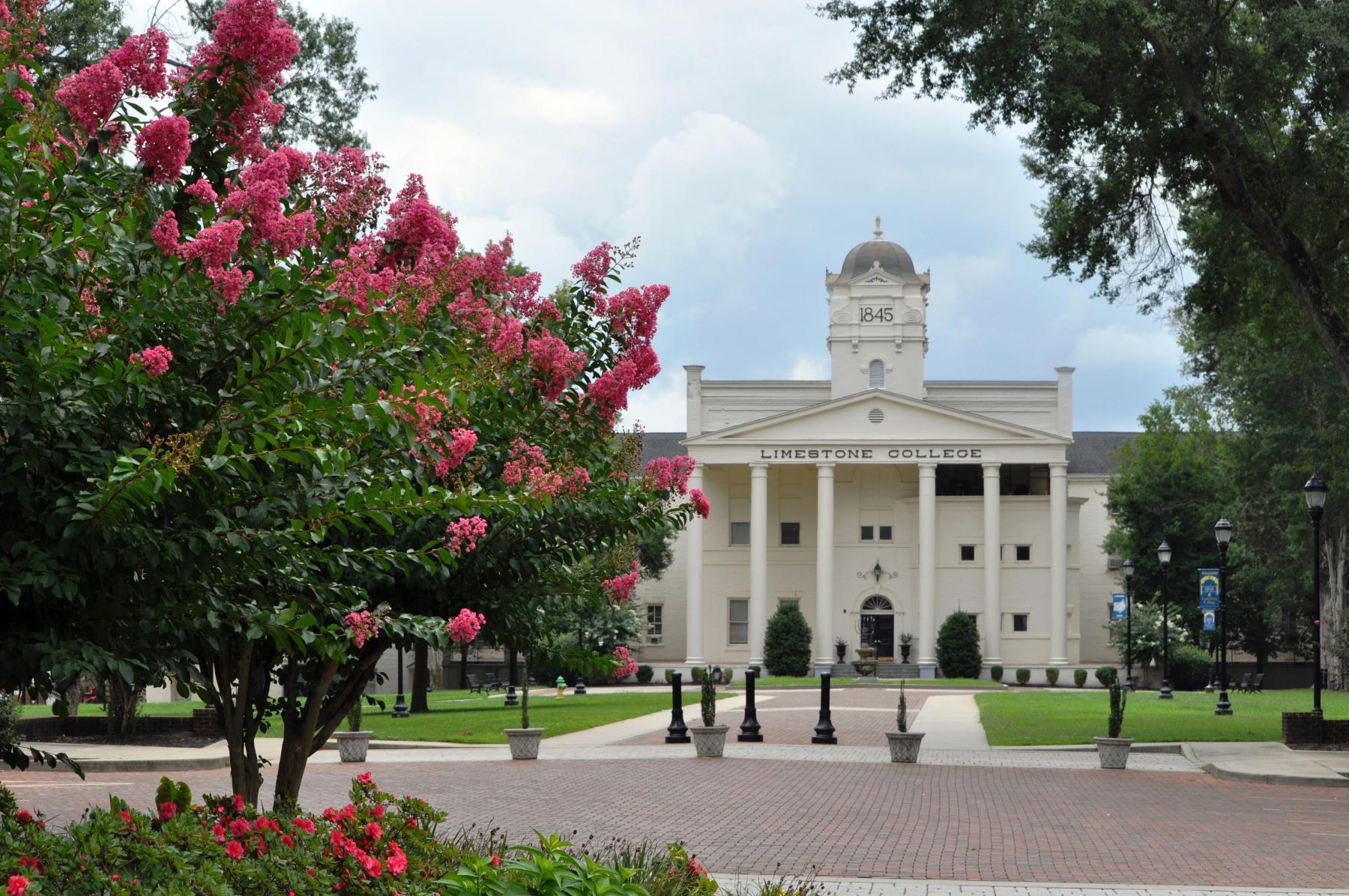
The Limestone College Story
Limestone has always been a pioneer in providing access to higher education for those who otherwise might not have enjoyed that access. In 1845, when higher education was only a dream for young women, Limestone was founded as the first women’s college in South Carolina and one of the first in the United States. In the early 1900s, when young men from the local area sought higher education, but could not afford to attend distant universities, Limestone admitted them as daytime commuting students.
In the 1970s, when most colleges and universities had no interest in educating working adults, Limestone established the Block Program, one of the pioneer programs for non-traditional students. The Block Program allowed students to complete their bachelor’s degrees entirely through evening classes. In the mid-1990s, through the establishment of what was known then as its Virtual Campus, Limestone emerged as a national leader in applying computer technology to teach students who could not utilize traditional classroom settings. In 2005, the Block Program and the Virtual Campus were combined into the Extended Campus Program (renamed the Online Program in 2020). Providing higher education access to those needing it the most has been a proud theme throughout the history of Limestone.
The institution that became Limestone College was founded by Dr. Thomas Curtis a Baptist minister and scholar who was born in England and immigrated to the United States in 1833. Dr. Thomas Curtis served churches in Maine, Georgia, and South Carolina, including the Wentworth Street Baptist Church in Charleston.
In 1845, Dr. Thomas Curtis was able to fulfill his dream of establishing an institution of higher learning for young women by purchasing a magnificent building at Limestone Springs, which had been constructed in the 1830s as a resort hotel. The village of Limestone Springs, now a part of Gaffney, had developed adjacent to a mineral water springs, which attracted families from the Midlands and Lowcountry who wished to avail themselves of the supposed medicinal value of the spring water and avoid the oppressive summer heat of their home regions.
Originally named the Limestone Springs Female High School, the new institution attracted the daughters of the most influential families of South Carolina, who sought the finest liberal arts education available at that time. On November 6, 1845, a total of 67 young women began their classes at Limestone.
Dr. Thomas Curtis assumed an active role in education beyond the confines of his own school. He was instrumental in organizing the South Carolina Teachers Association and founding the Southern Baptist Theological Seminary.
In 1859, when Dr. Thomas Curtis, was returning from a visit to the North, he perished in a shipboard fire on Chesapeake Bay. Leadership of the College passed to his son, Dr. William Curtis who was pastor of the First Baptist Church in Columbia.
Despite difficult financial times following the Civil War, Limestone managed to survive. Peter Cooper, a prominent industrialist and inventor, briefly considered the possibility of transforming Limestone into a Southern version of his famed Cooper Union in New York City. While his plans for Limestone did not materialize, in 1881 the school became known as the Cooper-Limestone Institute. In 1898, it became Limestone College.

During the late 19th and early 20th centuries, Limestone was fortunate to have Trustee leadership from two of the leaders of the textile industry in the Upstate of South Carolina, John Montgomery of Spartan Mills and Dr. Wylie Cicero Hamrick of Hamrick Mills. Montgomery served as chair of the Board of Trustees from 1888 until his death in 1902. Under his leadership and through his personal generosity, Limestone regained its stability and reputation. Dr. Hamrick served as a member of the Board of Trustees from 1899 until his death in 1935 and oversaw Limestone during its golden years of expansion. His descendants have played prominent leadership roles at Limestone down to the present day.
During the period of 1899 to 1966, Limestone College was led by three of the most influential presidents in the long history of the institution – Dr. Lee Davis Lodge (1899-1923), Dr. Robert C. Granberry (1923-1952), and Dr. Andrew Jackson Eastwood (1953-1966).
One of Dr. Lodge’s first endeavors was the construction of the Winnie Davis Hall of History. The unique structure, considered one of the most architecturally splendid buildings on any college campus, was occupied in 1904 and named for the daughter of Jefferson Davis and Varina Howell Davis. The new building was to be used to promote the study of Southern history and literature. Dr. Lodge proposed to make Limestone a great center of historical study, where the rich materials of the South could be collected, preserved, organized, and interpreted. Visiting scholars would share their knowledge with Limestone students. For the next 40 years, Limestone students who completed a prescribed sequence of History courses received a special diploma from the Winnie Davis School of History in addition to their Limestone diploma.
Limestone has always been deeply involved with improving educational opportunities in Gaffney and Cherokee County. In the late 1890s, shortly after the creation of Cherokee as a separate county, Limestone administrators supported the efforts of local citizens to establish a public school system. When the new system opened its doors, every teacher was a Limestone graduate. More than a century later, Limestone still provides many of the teachers for public schools in Cherokee County and the Upstate of South Carolina.
During World War I, Limestone continued its outreach efforts to the local community. Under the leadership of professor Eunice Ford, later dean of the College, Limestone established evening classes to assist local citizens in gaining the necessary literacy skills to serve their country both in the military and in critical civilian occupations.

In 1923, Dr. Lodge was succeeded by Dr. Robert C. Granberry. Many of the buildings on Limestone’s front campus date from his presidency. Both the Hamrick Hall of Science, a gift from Dr. Hamrick who was then serving as chair of the Board of Trustees, and the Carroll School of Fine Arts, a gift from longtime benefactor James A. Carroll, were completed in 1925.
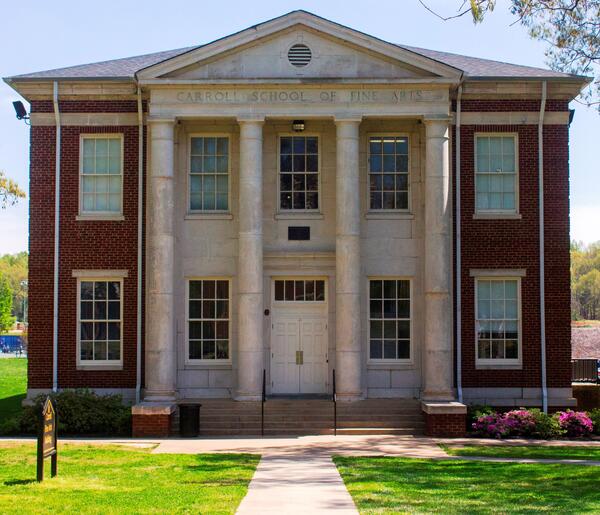
Limestone was formally affiliated with the South Carolina Baptist Convention from 1921 until 1941. The relationship ended amicably when control of the institution passed to a self-governing Board of Trustees. In 1928, Limestone College received regional accreditation from the Southern Association of Colleges and Schools (SACS), an accreditation that has been continuously maintained since that date.
In 1953, Dr. Andrew Jackson Eastwood, longtime professor of History, ascended to the presidency of Limestone. During his tenure, student enrollment increased, admission standards were raised, and the relationship between the College and the local community was strengthened.
Fullerton Auditorium, completed in 1964 and seating nearly 1,000 guests, continues to provide one of the finest performance venues in the area. Limestone’s priceless Aeolian-Skinner organ, constructed by G. Donald Harrison, who also built the organ for the Mormon Tabernacle in Salt Lake City, was moved into the new auditorium.
Following the death of Dr. Eastwood in 1966, Limestone experienced many of the challenges facing other higher education institutions during those turbulent years. During the next 26 years, the College had eight presidents, three of them serving on an interim basis.
Male commuting students were allowed on campus in the early 20th century, but there were no residence halls for men until the late 1960s when Limestone became coeducational. With desegregation occurring throughout the nation, African-American students were admitted to the College for the first time. In recent years, Limestone has been cited for the diversity of its student body. In 2020, Limestone endowed a scholarship in honor of Annette Reynolds, the first African-American student enrolled at the institution.
As previously noted, in the 1970s, Limestone developed a novel, accelerated approach to education for working adults. The Block Program, which has served as a national model for successful evening programs, gave working adults the opportunity to complete their degrees without sacrificing their jobs.
Dr. Walt Griffin became President of Limestone College in 1992, at a time when the institution was experiencing dwindling enrollment, major financial deficits, and deteriorating buildings. However, Limestone not only recovered from the hard times of the 1980s, but also flourished during his presidency until he retired in 2017.
Dr. Darrell Parker was introduced as Limestone’s President in January of 2018 and served until his resignation in January of 2023. Former Provost Dr. Monica Baloga was named the University’s Interim President in February of 2023 and served until her resignation in September of the same year.
The Board of Trustees named Jeremy Whitaker, the Vice President for Finance & Administration, as Limestone’s Acting President in September of 2023 and he served in both roles through April of that same year.
Limestone’s Board of Trustees selected Dr. Nathan B. Copeland as Limestone’s 24th President in April of 2024. Dr. Copeland took office as Limestone’s President on May 13, 2024.
In addition to being regionally accredited by the Southern Association of Colleges and Schools (SACS) since 1928, Limestone has numerous departmental accreditations. The most recent was for Business (ACBSP) in 2017. The University also has departmental accreditation for Athletic Training (CAATE); Music (NASM); Social Work (CSWE); and Teacher Education (NCATE), including Physical Education, English Education, Math Education, Early Childhood Education, Elementary Education, and Music Education.
Limestone has several Online Programs that continue to be recognized recently as some of the best in the country.
Limestone Saints Athletics
Limestone’s intercollegiate athletics program began during the 1972-1973 academic year with four sports: men’s basketball, men’s tennis, men’s golf, and women’s volleyball. Blue, gold, and white were selected as the school colors. The selected nickname for the athletic teams was “Saints,” and a Saint Bernard dog was chosen as the Limestone mascot. Facilities for intercollegiate athletics improved dramatically in 1976 with the opening of the Timken Physical Education Center, which contained a 1,500-seat basketball arena and an aquatic center. In 1984, the men’s golf team brought home Limestone’s first national title, winning the National Association of Intercollegiate Athletics (NAIA) Championship. Limestone added a men’s baseball program in 1987 and selected as its first coach former major league pitcher and future Hall of Fame member Gaylord Perry.
In 1991, Limestone secured membership in NCAA Division II, and in 1998 joined the Carolinas-Virginia Athletic Conference (CVAC). In 2007, the name was changed to Conference Carolinas. In 2020, Limestone athletics joined the South Atlantic Conference (SAC).
The men’s and women’s lacrosse teams have enjoyed particular success at the national level. The men’s team won NCAA Division II National Championships in 2000, 2002, 2014, 2015, and 2016. The women’s lacrosse team advanced in both 2011 and 2013 to the National Championship finals.
In October 2005, Limestone dedicated the Walt Griffin Physical Education Center containing a state-of-the-art Fitness Center and athletic training facilities, a wrestling practice area, locker rooms, classrooms, and offices.
Field hockey, men’s volleyball, football, acrobatics & tumbling, and women’s wrestling have been added in recent years, bringing the total number of intercollegiate sports to 25. Limestone also offers competitive cheerleading and dance. The Saints played their inaugural football season in 2014.
Limestone's Historic Buildings & Facilities
Nine of the buildings on Limestone’s front campus are on the National Register of Historic Places, along with the former quarry – which is now a picturesque lake on campus.

The front campus buildings (constructed between ca. 1837 and 1941) listed on the National Register of Historic Places include Hamrick Hall of Science, Carroll School of Fine Arts, Winnie Davis Hall of History, Granberry Hall, Curtis Administration Building, Limestone Springs Hotel (later known as Cooper Hall and now considered part of the Curtis Administration Building), Dobson Center, Eunice Ford Residence Hall, and Ebert Residence Hall.
Deposits from the Limestone Quarry, furnished lime used in the production of iron during the American Revolution and throughout the 19th century. By the 1820s, the open pit was a quarry owned by U.S. Congressman Wilson Nesbitt and was on a large tract including Limestone Springs which later became a popular resort. The site was often referred to as “Nesbitt’s Quarry.” It was acquired by Limestone prior to the Civil War and was sold to pay debts in 1883. It operated until World War I, when it was closed and filled with water. It reopened in 1933 after pumping out the water, and the mining of limestone and the production of lime continued until the deposits there were exhausted in 1953. The quarry, since filled with water, was listed in the National Register of Historic Places in 1986. The South Carolina stone placed in the Washington Monument was mined from the quarry located on the Limestone campus.
In recent years, Limestone has completed major renovations to most of its campus buildings. The Winnie Davis Hall of History fell into disrepair in the 1970s and remained out of use until 2010 when a $4.8 million initiative transformed the magnificent building into a multimedia academic hall with six contemporary classrooms, museum and art gallery space, and faculty offices.
Campus Growth & Expansion
Limestone can boast of the addition of several other buildings to the campus in the early part of this new century.
The Physical Education Center, constructed in 2005, was renamed the Walt Griffin Physical Education Center in 2009.
A new residence hall, with a capacity of 96 students, was opened in early 2011. It was named for Vivian and George Carl Ball in 2015. At the corner of O’Neal and Griffith Streets, the 200-bed Walter W. Brown Residence Hall opened in the fall of 2016.
The Limestone Center, acquired from the Cherokee County School District, was completely renovated in 2010 and today affords excellent facilities for both intercollegiate athletics and Limestone’s Department of Theatre.
The former YMCA building on campus was acquired by Limestone in 2010 and renovated for both academic and student service uses as part of the Timken Center.
A building in downtown Gaffney was leased by the College in 2012 primarily for use by the Music Department.
Limestone acquired two nearby apartment complexes, The Cedars and Walton Ridge, for student housing in 2013.
The historic Fort House, a two-story brick home located on Overbrook Drive, was donated to Limestone in 2010. It has been used for several purposes over the years.
The Landon House near the Camp-Swofford Chapel was acquired in 2014 for the Christian Education Leadership Program (CELP). The nearby Agape’ House was acquired for CELP in 2015, with a third house added in2020
The Bob Campbell Field House, providing locker facilities for 477 student-athletes, opened in the fall of 2014. It is connected directly to the Limestone Center.
Shannon Hamrick Park, which opened in the spring of 2019 near Limestone’s baseball stadium, was made possible by a gift from Barry and Judy Hamrick in memory of their late son. As a part of the park, the areas along the back and sides of the baseball grandstands had brick facades and signage added. A raised patio area that includes tables and umbrellas sits along the third base side of the field and offers a new seating area for baseball spectators. In addition, new restroom facilities have been constructed.
The Cunning Victory Bell Tower was also dedicated in the spring of 2019. Named in memory of the late Barbara Cunning by her husband Dr. Charles Cunning, the Victory Bell Tower overlooks the Limestone quarry and is situated between the University's athletic and academic facilities. The Bell Tower plays the “Blue and Gold” fight song to recognize athletic victories and other monumental occasions at the University. The ornamental bell inside the tower hung from the top of the Curtis Administration Building for several decades until it was removed in 1998. For many years after it was acquired in the 1800s, the bell summoned Limestone’s students to their classes and meals.
The legacy of legendary Gaffney High School coach and Cherokee County educator Robert E. “Bob” Prevatte now has a permanent home at Limestone, thanks to a record-breaking $4.1 million gift from Jerry Richardson, who played for Prevatte when he served as an assistant football coach in North Carolina prior to his coaching career in Gaffney. The Bob Prevatte Athletic Complex was dedicated in the summer of 2019. The highlight of the dedication was the unveiling of the Bob Prevatte statue at the community entrance of the complex located off Leadmine Street in Gaffney.
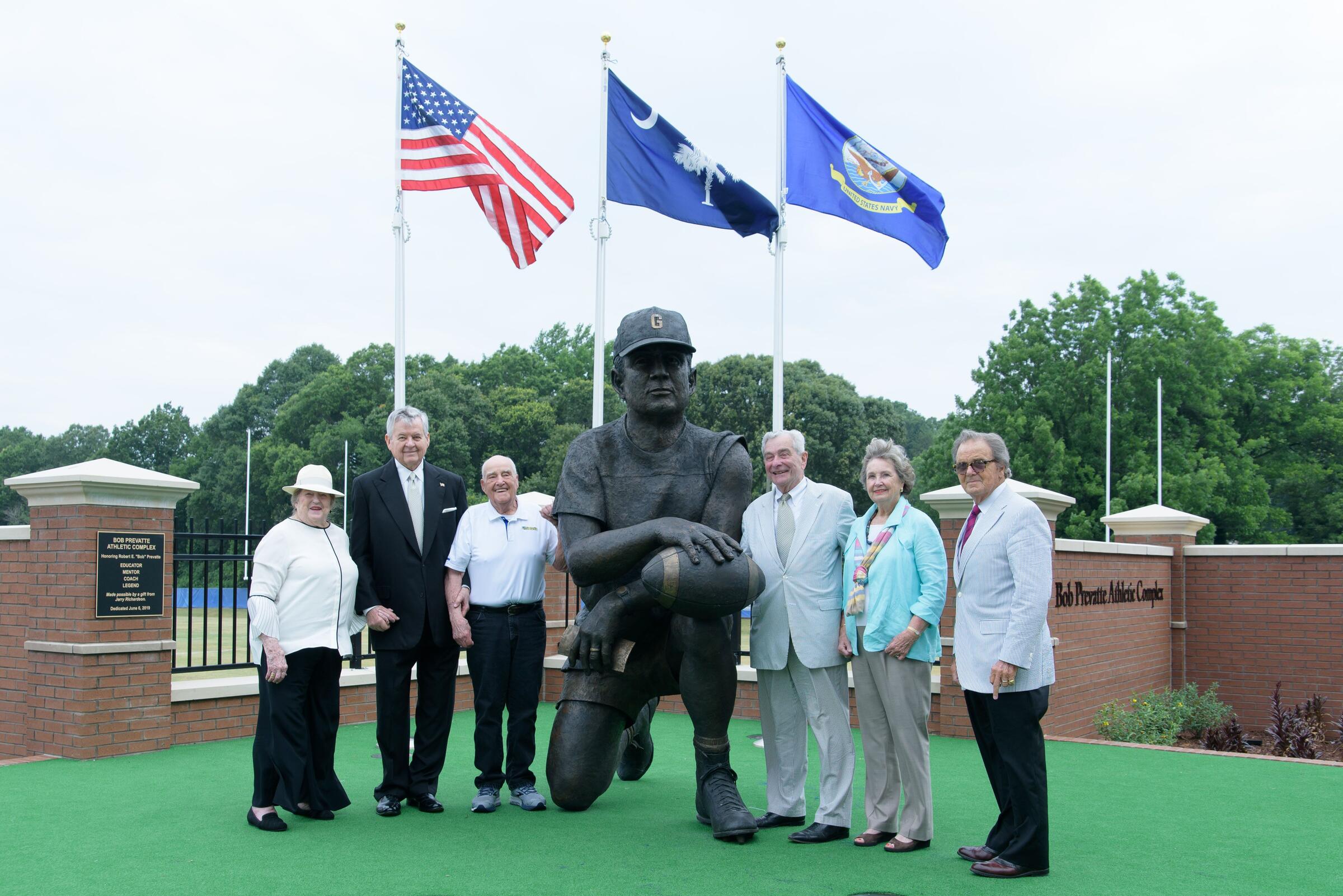
In addition to the statue and new entrances and signage, the Prevatte Complex has provided aesthetic enhancements and many new elements to the campus. Some of those include a new artificial turf practice field, permanent seating at Saints Field (which hosts lacrosse, soccer, and field hockey), community gathering spots, decorative fencing, and more. The campus connector walkways and a new bridge physically connect the academic portion of Limestone’s property to the athletics facilities.
In the fall of 2021, Limestone officially opened its new three-story, 65,000-square-foot library and student center. Known as the Hines & Riggins Center, the multi-million-dollar facility was made possible as part of the United States Department of Agriculture (USDA) Rural Development Program.
The new student center is on the first floor of the building and includes a commons area, the Limestone Art Gallery, the Spirit Store, meeting and banquet rooms, and additional student dining options. The library portion is located on the second and third floors. The library includes advanced computer and audiovisual technology, a writing and math center, reading area, classrooms, and student work areas.
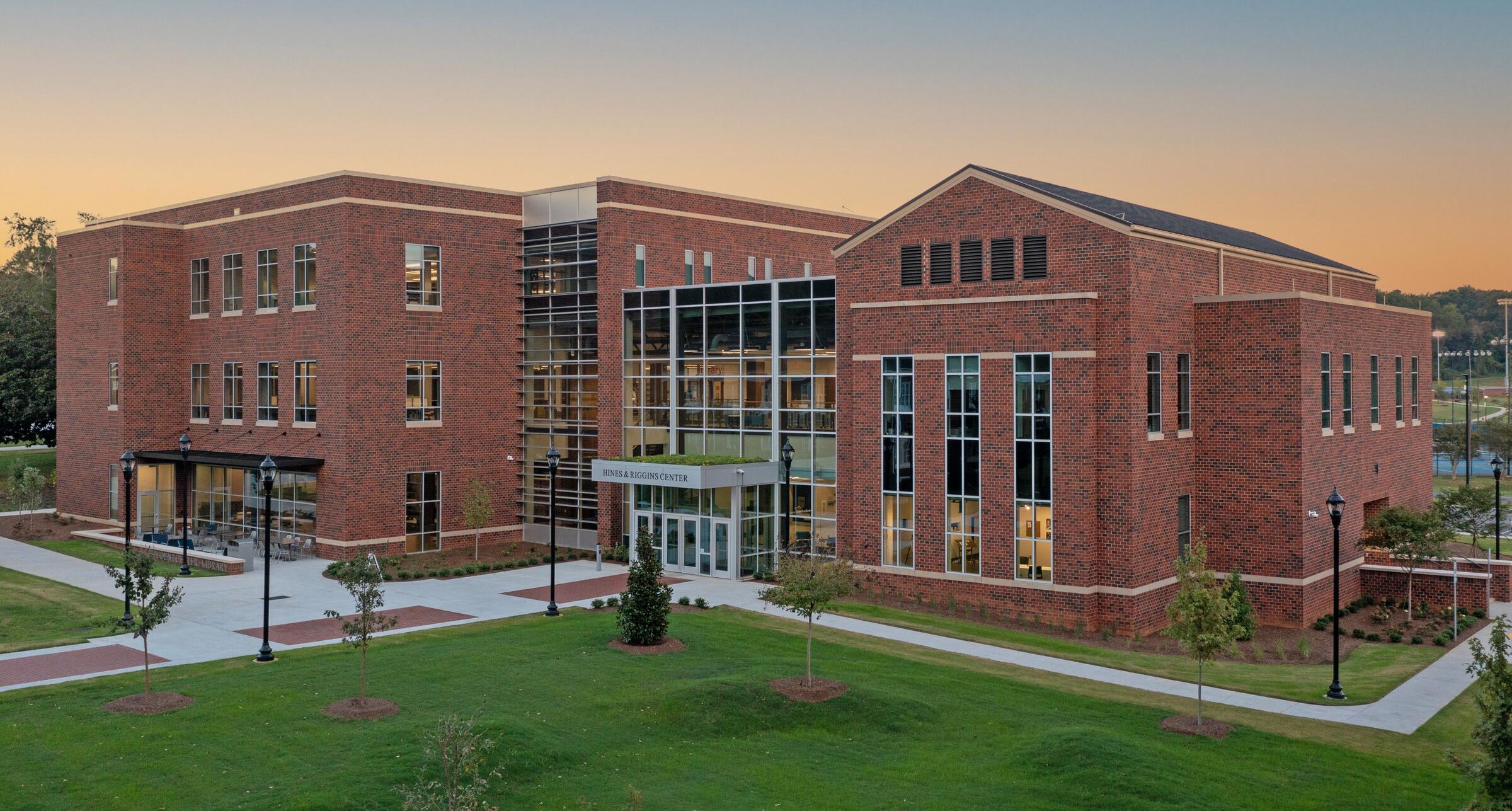
Thanks to a partnership with Ball Horticultural, a new landscape master plan was started in 2020 to beautify the campus and provide structured outdoor space for student life. That included a new outdoor amphitheater located in front of Granberry Hall that opened in the fall of 2020.
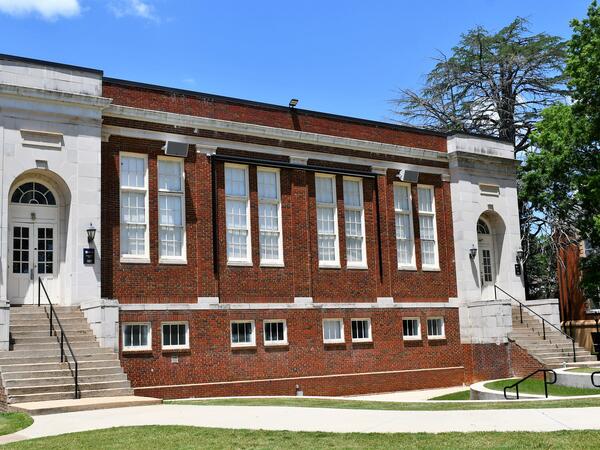
New Programs & Initiatives
In 2018, Limestone officials unveiled plans for its new Global Experience Program that sends undergraduate Day Campus students to some of the most iconic locations in the world. The costs for one trip during a student’s time at Limestone will be covered through tuition. Flights, ground transportation, lodging, meals, and travel healthcare insurance will be covered by Limestone. Each “Global Experience” is designed with a specific academic focus and is chaperoned and taught by Limestone professors.
Limestone started the Diamond Resorts Internship Program in 2019 that offers Limestone junior and senior students the opportunity to get on-the-job training via semester-long internships. Diamond Resorts is a global leader in the hospitality, vacation ownership, and entertainment industries. Successful completion of the internship not only earns students a full semester’s worth of credits, they are also guaranteed a position with Diamond Resorts after graduation.
In late 2019, Limestone announced an articulation agreement with the Edward Via College of Osteopathic Medicine (VCOM), which is a doctoral-level osteopathic medical college with a nearby campus in Spartanburg. The University’s partnership with VCOM provides its pre-medical students an opportunity to receive a Guaranteed Admissions Interview, as well as take part in an Early Admission Program.
In partnership with the Cherokee County School District, Limestone’s new Scholars Academy that opened in the fall of 2020 gives a limited number of academically motivated high school students the opportunity to complement their study and earn college credits while attending classes on Limestone’s campus. The program enables local students to take college courses and advanced high school classes over four years while still participating in extracurricular activities at their own schools.
The Scholars Academy allows top academic students from the local district to be challenged by a combination of Honors, Advanced Placement, and Dual Enrollment courses. Scholars will gradually move from self-contained classes in their first year to all dual enrollment by their senior year. Academic advisors from the district and the University work together to help the students choose paths that lead to degree options at Limestone or transfer options to other schools. Participants will have the prospect of earning an associate degree at Limestone while still in high school. The students will graduate with a high school diploma and a maximum of 85 college credits once the program is fully implemented. After graduating from the Scholars Academy, students can continue at Limestone University and complete their college degrees in as little as two years. They also have the option to transfer their eligible credits to another institution.

